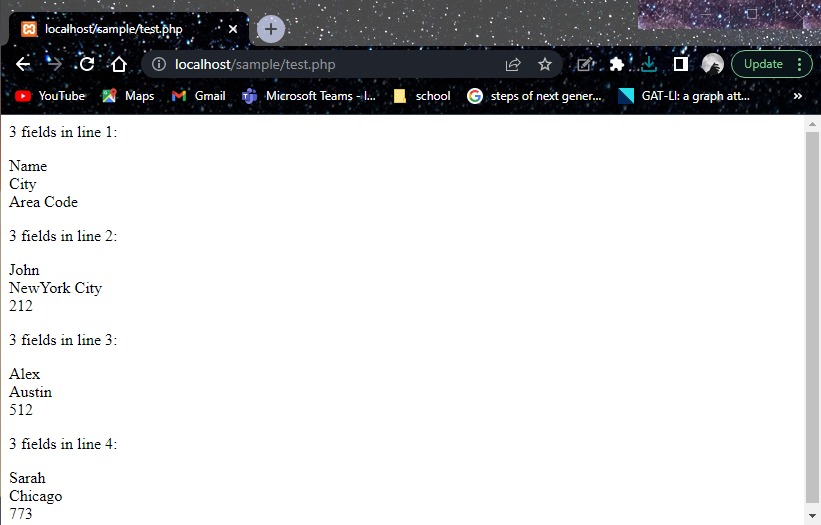In this article, we will delve into the details of how to use the fgetcsv() function in PHP, covering everything from its syntax and parameters to practical examples that illustrate its usefulness.
What is fgetcsv() Function?
The fgetcsv() function in PHP is used to read a line from a CSV file and return the values as an array. It takes two arguments, the first one is the file pointer, which is used to identify the CSV file and the second argument specifies the length of the line. The function returns an array that contains the CSV file’s values.
The syntax for fgetcsv() function in PHP is:
The parameters given for fgetcsv() function are:
File: This parameter is mandatory and identifies the file from which to retrieve and parse a line. You can use the fopen() function to open a file in PHP and then pass its resource to fgetcsv().
Length: This parameter is optional and specifies the longest possible line length. If this parameter is not specified, PHP will use the default value of 0, which means that the maximum line length is not limited. If you know the maximum line length of your CSV file, it is recommended to specify this parameter to improve performance.
Separator: This optional parameter specifies the character that is used to divide the fields in the CSV file. The default value is a comma (,). However, you can specify a different separator character by passing its ASCII code as an integer value. For example, if you want to use a tab as the separator, you can use the ASCII code 9.
Enclosure: This parameter is optional and specifies the character used to enclose fields that contain the separator character. The default value is a double-quote (“). If a field contains the separator character, it must be enclosed in this character to avoid confusion. If your CSV file uses a different enclosure character, you can specify it using this parameter.
How to Use fgetcsv() Function in PHP?
Follow the below-given steps to use the fgetcsv() function in PHP.
Step 1: Open the CSV file using the fopen() function in PHP. Specify the file’s location as an argument to fopen().
Step 2: Loop through the file using a while loop and call the fgetcsv() function inside the loop. The loop will continue until the file is terminated.
Step 3: Use the fgetcsv() function to read individual lines from the file. To do this, call the fgetcsv() function, passing in the handle of the open file as the argument. The function will return an array of the fields on that line.
Step 4: Perform necessary actions on the data retrieved from the file. You can use this data to perform whatever actions you need to do.
Step 5: Loop through the file once more until all lines have been handled.
Step 6: Once you have finished processing the file, close it using the fclose() function.
The test.csv file has the following content:
Here’s a sample code that illustrates how to use fgetcsv() function:
$row = 1;
if (($handle = fopen("test.csv", "r")) !== FALSE) {
while (($data = fgetcsv($handle, 1000, ",")) !== FALSE) {
$numbers = count($data);
echo "<p> $numbers fields in line $row: <br /></p>\n";
$row++;
for ($c=0; $c < $numbers; $c++) {
echo $data[$c] . "<br />\n";
}
}
fclose($handle);
}
?>
Note: It is necessary to specify the path of the file if it is in a different directory.
In the above code, the data is read from the “test.csv” CSV file. The CSV file is opened in read-only mode using the fopen() function, and data is read from each line using the fgetcsv() function. While iterating through each line of the file, the while loop uses the count() function to count the number of fields in each line and stores the result in a variable called $numbers. Then, using echo statements, it repeats the number of fields and the line number. Lastly, it repeats the values of each field on the current line in a loop before breaking the line. The code uses the fclose() function to close the file after reading every line.
Output
Note: It is crucial to deal with potential errors when using the fgetcsv() method. For example, the function may return NULL if the end of the file is reached or if there is an error reading the file. You can check for these errors and take appropriate action to handle them.
Conclusion
For PHP developers that need to work with CSV files, the fgetcsv() function is necessary as it makes reading and manipulating CSV files easier by returning an array of values from each line. The function can read CSV files efficiently by setting the file pointer, line length, separator, and enclosure. The sample code in this article shows how to successfully use the fgetcsv() function to read data from a CSV file. It is critical to managing any potential mistakes that may occur when using this function.


